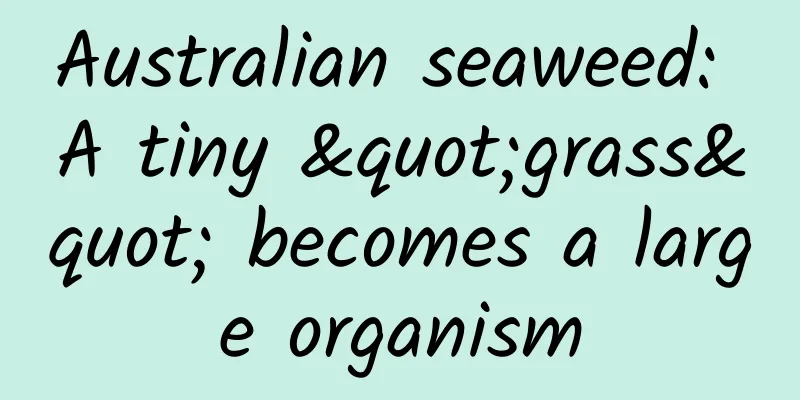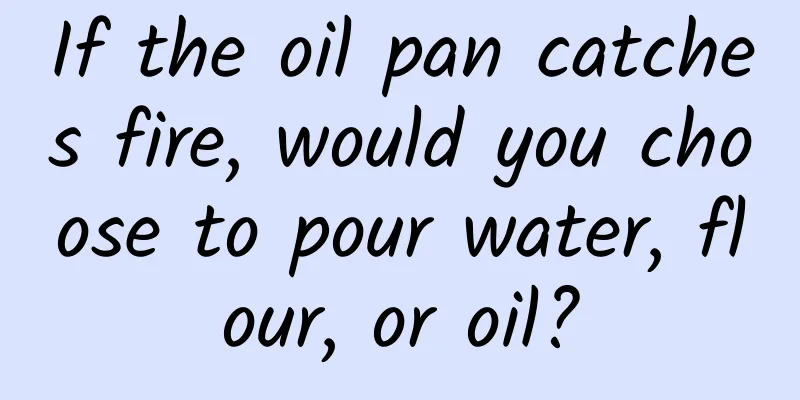Australian seaweed: A tiny "grass" becomes a large organism

|
If you ask which animal in nature is the largest, I believe everyone will nominate elephants, blue whales and other creatures. But in fact, the largest organism in the world appears to be "inconspicuous" on the surface. It is the "seaweed" swaying in the wind. The magical waterweed that blooms in the sea So how did a tiny blade of grass become the world's largest organism? What's so special about it? Why is this largest organism now threatened? Let's take a look at which blade of grass swaying in the wind is so powerful. Vast and beautiful underwater meadow Magical "grass" The magical "seaweed song" and "seaweed dance" have triggered a wave of imitations, and this very common plant in the ocean has suddenly become the focus of everyone's attention. Of course, many people also think that the existence of seaweed actually pollutes the sea, making the clear sea water a little "ugly", so they are very disgusted with them. However, the "seaweed army" does not care whether humans have any objections or not. They will grow wantonly in the sea and cover large areas of the sea. The "seaweed" we are going to introduce today is located in Shark Bay, the westernmost part of Australia. Different types of seaweed grow here. As can be seen from the picture, these seaweeds form a huge "seaweed plain". Shark Bay's "seagrass plains" Many biologists are very interested in the seagrass here, and have gone to various areas here to collect samples, trying to sort out the "family tree" of the seagrass family. So they collected samples at a location in 2020 and conducted genetic testing on these samples. We thought that these far-flung seaweeds were at most distant relatives, but the test results showed that samples from 9 locations all belonged to the same type of seaweed, which was "Australian Poseidon". Specimen of Australian seaweed After making this special discovery, evolutionary biologist Elizabeth Sinclair immediately launched a larger-scale study and eventually found that the vast majority of seaweed in Shark Bay behaved genetically in exactly the same way, proving that they all had the same "ancestor." For this reason, they believe that there should have been only one plant in the vast seaweed in Shark Bay at the beginning, and this small "grass" replicated itself day after day, and eventually the clones occupied a large area of the seabed. Underwater photo of Australian seagrass in Shark Bay The span of this seagrass bed reaches 180 kilometers and covers an area of about 200 square kilometers. It is estimated that it would take at least 4,500 years for the original grass to spread to this extent. Therefore, it is not only the largest organism in the world, but also has a long lifespan. Researcher Elizabeth Sinclair said: "This is the largest known clone on Earth and arguably the largest organism in the world." The ever-expanding Australian seaweed It is worth mentioning that in fact all seagrasses in the world reproduce by cloning, and there are also huge seagrass beds in the Mediterranean and Baltic Seas. However, there is no "polyploid seagrass" in these areas, while the Australian seagrass in Shark Bay has long escaped the restriction and become a tetraploid organism. This characteristic allows it to survive dramatic changes in the environment, and it has been cloning and replicating over the past few thousand years, making its family even larger. Therefore, for the seagrass in Shark Bay, this is essentially an evolution, which not only makes the individual more adaptable, but also allows the population to reproduce. Seagrass creates clones by extending rhizomes However, even seaweed that has found the "diffusion code" in a long evolution process is facing threats after becoming the largest organism in the world. It may even become smaller and smaller under this threat until it eventually disappears. How is seagrass threatened? In fact, from the above discussion, we can see that when humans study seagrasses, they rarely target a single plant, and even when sampling, they "blindly select" within a large range. And these seagrass beds that seem to be growing and getting bigger are actually in the process of retreating. Schematic diagram of seagrass distribution and changes in Europe At present, there are 12 genera and more than 50 species of seagrass in the world, with a total area of about 0.6×10^6 square kilometers, equivalent to about 10% of the offshore area. Since it grows in offshore areas, it is relatively easy for humans to conduct a "census" of seagrass. This creature thrived in coastal waters thanks to its powerful cloning ability, but it has been declining rapidly since the 1980s. According to current statistics, nearly 30% of the world's seagrass beds have disappeared, and the remaining seagrasses are also facing some threats. Seagrass is an indispensable organism in the ocean Humans undoubtedly play an important role in the degradation of seagrass beds. With the development of technology, human operations in the coastal areas have become more and more frequent, and many construction activities will cause damage to the coastal seagrass beds. However, humans who only pursued profits at that time did not care. After all, it was just a piece of seagrass, and its disappearance would not cause any harm. Later, global climate change made the situation of seagrass even more difficult. For example, the El Niño event between 1995 and 1998 brought heavy rainfall to a bay in the United States, which ultimately led to excessive nitrogen input and significantly slowed the growth of seagrass in the area. El Niño event observed in 1997 In addition, there is eutrophication of water bodies, etc., which will have a potential impact on the growth and survival of seagrass. Unfortunately, because many people do not care about these "tiny creatures" in the sea, it is difficult to perceive the response of seagrass beds to drastic environmental changes. However, according to scientists' current research, seaweed has successfully demonstrated that although a single plant is inconspicuous, when gathered together they can cause a huge impact. Eutrophication affects photosynthesis of aquatic plants So, what is the significance of the existence of seagrass beds? Do they contribute anything to the earth as they sway in the sea? Carbon sequestration capacity of “seagrass ecosystems” In recent years, people all over the world have been troubled by the problem of global warming, because the negative impacts of global warming have become apparent and are in the process of expanding. If we could pretend nothing happened in the past, the reality now does not allow people to play dumb. Schematic diagram of global surface temperature changes Therefore, in recent years, in addition to thinking about how to reduce carbon emissions, humans have also been looking for things in nature that have the ability to fix carbon. For example, in order to achieve "carbon neutrality" as soon as possible, my country has been working hard to plant trees in recent years. According to "Blue Carbon: The Role of a Healthy Ocean in Carbon Fixation" jointly released by the United Nations Environment Programme, the World Conservation Union and others in 2009, the ocean's carbon fixation function may actually be more powerful than the solid-state capacity of terrestrial organisms. Schematic diagram of the ocean carbon fixation and storage process The report points out that although the biomass of marine plants is only 0.05% of that of terrestrial plants, their productivity is very high, and the scale of their carbon cycle is similar to that of terrestrial plants. They are one of the most dense carbon sinks in the entire Earth's biosphere. Among the ocean carbon fixation forces, the most outstanding one is the seaweed we introduce today. Although it looks small and only "sways in the wind" on a daily basis, its area is nothing compared to the total area of the ocean, but its carbon fixation ability is extremely strong. Schematic diagram of the carbon cycle of seaweed Studies have shown that its average carbon fixation rate is about 21 times that of tropical rainforests, making it a veritable "carbon fixation expert." Research by Fourqurean et al. shows that the global organic carbon reserves in seagrass bed sediments are between 9.8 and 19.8 Pg C (Pg = 10^15g), which is equivalent to the sum of the carbon reserves in the global mangrove and intertidal salt marsh plant sediments. Comparison of carbon sequestration capacity of coastal ecosystems The data shows that the carbon sequestration capacity of seagrass beds is indeed extremely strong. And as relevant research continues to advance, many experts have pointed out that the role of seagrass in carbon sequestration is far more important than humans imagine. Take Spain's Balearic Islands for example. The carbon sink value created by seagrass here is about 35 times that of tropical rainforest of the same area. Therefore, many scientists are calling on people to reduce their activities in shallow waters to avoid affecting the survival and growth of seagrasses. On the other hand, they are also stepping up research on how to artificially restore the degraded seagrass beds so that they can regain their former vitality. Transplanting eelgrass helps restore seagrass ecosystems Sometimes, however, it is difficult to solve all problems artificially, so now we still have to focus on "protection". At least we cannot let the seagrass beds as large as those in Shark Bay continue to recede or even disappear. It is hard to imagine how carbon dioxide levels would soar if humans lost all the seagrass. What do you think about this? Welcome to leave a message in the comment area. Follow CHN Jiuxiang Technology, and through popular science, you will find that there are too many wonderful things in this world. |
<<: How dangerous are “killer bees”? Can they be killed?
>>: If aliens come, can humans hide if they can't defeat them?
Recommend
Starbucks’ marketing tactics!
Impacted by the epidemic in 2020, the global econ...
Zhihu traffic growth rules!
In the past November, Zhihu released its Q3 2021 ...
Why are we so sure that extreme weather is caused by global warming?
Global warming changes the probabilities of rando...
US media: China will become a global leader in technology
According to the Seattle Times on December 28, wi...
Ten questions and answers about COVID-19 "re-positivity" and "reinfection"!
Source: People's Daily WeChat...
Why can't you create a knowledge carnival in the Himalayas?
For the platform, creating a nominal "festiv...
The battle between enthusiasm and rationality in the video industry from the hit of "The Pancake Man"
The movie "The Pancake Man" invested an...
TrendForce: DRAM average price decline is expected to narrow to 13-18% in Q1 2023
According to a recent report released by TrendFor...
If plagiarism can’t be stopped, will WeChat mini-games still be good?
[[238589]] Who doesn't have a past life? Core...
Wearable devices may promote the integration of wireless technology
[[147161]] Although most of the current wearable ...
At the Genting Observatory, this group of "post-90s" and "post-00s" are "measuring the temperature" of the earth!
In mid-November, the snow-capped Waliguan Mountai...
Taking stock of the "history of the operational war between Tik Tok and Kuaishou"!
How do you evaluate the operation of Douyin ? Thi...
"Capturing electricity" in water, creating a new way of green energy | Interview with Academician Guo Wanlin
As the world's largest hydroelectric power st...
Home appliances will become a new hot spot for promotion as sales channels sink
With the popularization of broadband and the deve...
Leaking urine when coughing? This "embarrassing" disease is ignored by many people...
Expert of this article: Zhu Hongjian, Chief Physi...









![[Practical Information] Information flow advertising landing page treasured by people from all industries!](/upload/images/67cc2792d0a40.webp)